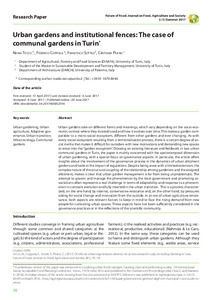| dc.date.accessioned | 2017-06-27T11:16:24Z | |
| dc.date.available | 2017-06-27T11:16:24Z | |
| dc.date.issued | 2017-06-20 | |
| dc.identifier.issn | 2197-411X | |
| dc.identifier.uri | urn:nbn:de:hebis:34-2017060852594 | |
| dc.identifier.uri | http://hdl.handle.net/123456789/2017060852594 | |
| dc.language.iso | eng | |
| dc.publisher | Department of Organic Food Quality and Food Culture at the University of Kassel, Germany and Federation of German Scientists (VDW) | eng |
| dc.rights | Urheberrechtlich geschützt | |
| dc.rights.uri | https://rightsstatements.org/page/InC/1.0/ | |
| dc.subject | Urban gardening | eng |
| dc.subject | Urban agriculture | eng |
| dc.subject | Adaptive governance | eng |
| dc.subject | Urban transition | eng |
| dc.subject | Urban ecology | eng |
| dc.subject | Communal gardens | eng |
| dc.subject.ddc | 630 | |
| dc.title | Urban gardens and institutional fences: The case of communal gardens in Turin | eng |
| dc.type | Aufsatz | |
| dcterms.abstract | Urban gardens take on different forms and meanings, which vary depending on the socio-economic context where they located/used and how it evolves over time. This makes a garden comparable to a micro-social ecosystem, different from other gardens and ever changing. As with every social-ecosystem resulting from a territorialisation process, there is a certain degree of social inertia that makes it difficult for outsiders with new motivations and demanding new spaces to enter into the “garden ecosystem”. Drawing on existing literature and fieldwork in two urban communal gardens in Turin, the paper is mainly concerned with the spatiotemporal dimension of urban gardening, with a special focus on governance aspects. In particular, the article offers insights about the involvement of the governance process in the dynamics of urban allotment gardens and looks at the impact of regulations. Despite being areas with a limited extension, the complex nature of the structural coupling of the relationship among gardeners and the assigned allotment, makes it clear that urban garden management is far from being unproblematic. The attempt to govern and manage the phenomenon by the local government and promoting associations often represents a real challenge in terms of adaptability and response to a phenomenon in constant evolution and fully inserted in the urban transition. This is a process characterized, on the one hand, by internal, conservative resistance and, on the other hand, by pressures asking for social change and innovation from the outside. In an era of urban agriculture renaissance, both aspects are relevant factors to keep in mind to face the rising demand from new people for cultivating urban spaces. These aspects have not been sufficiently considered in the governance practices or in the reflections of the scientific community. | eng |
| dcterms.accessRights | open access | |
| dcterms.bibliographicCitation | In: Future of Food: Journal on Food, Agriculture and Society. Witzenhausen : University of Kassel, Department of Organic Food Quality and Food Culture. - Vol. 5, No. 1 (2017), S. 70-78 | |
| dcterms.creator | Tecco, Nadia | |
| dcterms.creator | Coppola, Federico | |
| dcterms.creator | Sottile, Francesco | |
| dcterms.creator | Peano, Cristiana | |


